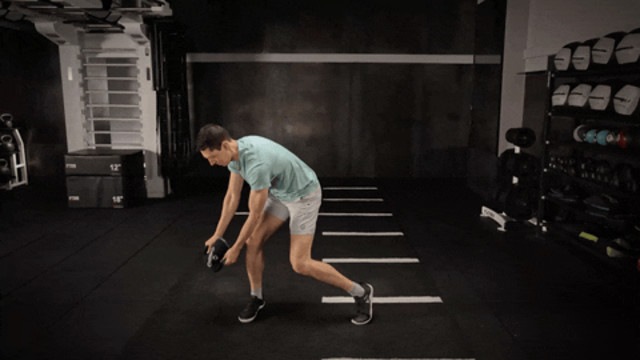Lift sand to unlock better functional fitness, grip strength, and power.
Do More With is a series highlighting equipment around the Club that can help you reach your fitness goals. In this installment, we highlight sandbags and SandBells, available on the Club floor and in Group Fitness Classes.
When it comes to workout equipment, I’m not married to one single gadget. As a Coach+, I prefer to use a handful of different training tools that all work together to help members achieve specific goals — and keep them interested and locked into their sessions. Pieces that challenge their bodies in unique ways, including sandbags.
Classic sandbags look a lot like the duffle suitcases you’d bring on overnight trips, but they’re filled with heavy sand (weighing up to 200 pounds total in some cases) and equipped with multiple handles to grip. There are also SandBells — neoprene, sand-filled discs that weigh up to 50 pounds and are free of handles, so you have to grasp the bag itself.
The tools have subtle differences, but at their core, they offer the same main benefit: better functional fitness.
Why Train with Sandbags
Whether you use traditional sandbags or innovative SandBells, you’re building functional strength. The weight in a sand-filled piece of equipment isn’t fixed, as is the case with barbells and kettlebells. Instead, it shifts from side to side — it's never going to be perfectly balanced all around.
That’s exactly what you encounter in the real world. Imagine you’re carrying grocery bags in both of your hands and walking to your car or up your apartment’s stairs. Those bags aren’t going to be the same weight, and the items inside aren’t going to be evenly distributed. You need to establish strength during times of instability — including with sandbags — in the Club so you’re able to accomplish those tasks easily in your everyday life.
The tools also challenge grip strength, a key component of functional fitness and a biomarker of aging. Research suggests that grip strength is a predictor of generalized strength, function, and bone mineral density, and there’s a link between low hand-grip strength and cardiovascular disease, stroke, type 2 diabetes, and other diseases. Sand-based weights can be used as part of a training program to develop a strong grip, as you’ll have to clench the handles of the heavy sandbags as you power through cleans and pinch the fabric of the SandBell during bent-over rows and hip swings, for instance.

RELATED: Train Your Forearms, Live Longer
They’re easy to add to your routine, too. For the most part, sand tools can be used in place of kettlebells, dumbbells, and barbells, helping to build strength, muscular endurance, or power depending on the exercises and how you program them together. The shifting nature of the sand adds an extra layer of difficulty, testing your stability, balance, and coordination. It makes you recruit different muscles than you normally would with a dumbbell or barbell.
How to Use Sandbags
Before training with sandbags, I recommend establishing a strong foundation with traditional resistance tools. Develop your body awareness and mind-muscle connection so you’re able to understand which muscles you’re engaging when doing specific exercises. Build strength in the ranges of motion that are available to you and practice proper breathing mechanics. Once you’re confident on those fronts, you can start introducing tools like the sandbag, which have that added layer of instability.
You might start with the basics for resistance training: Swap a pair of dumbbells for a sandbag, rack it in front of your shoulders, and rep out squats or lunge variations. Hold them at your sides, over one shoulder, or above your head as you perform carries. You can also do high plank pull-throughs with a SandBell, positioning it on the ground below your waist and pulling it from side to side with one hand. One of my favorites is a SandBell Turkish get-up, which feels much more difficult than a kettlebell version. Any time you’re training with kettlebells, ask yourself if you could do the same movement with two SandBells or a sandbag.
RELATED: Do More With: The ViPR PRO

Don’t overlook them for power training, either. Sandbags and SandBells are ideal for thrusters, power cleans, tosses, and slams — the latter of which have a slight edge over med ball variations. A SandBell won’t bounce back up to you, not even an inch, so you have to fully squat or hinge to grab the disc and reset to the starting position. With any of these exercises, you’ll test your muscles’ ability to generate large amounts of force quickly — and spike your heart rate in the process.
Despite all of the benefits, sandbags and SandBells shouldn’t be the only instruments you use in your training. Think of them as another tool in the shed, a way to introduce novelty into your routine when you’re feeling bored. Your body will appreciate the fresh approach.


Junhe Lee is a Coach+ at Equinox Tysons Corner outside of Washington, D.C. and has been at the Club for 15 years. Junhe is a Functional Range Conditioning mobility specialist and holds certifications in ViPR, kettlebell, and TRX training, Animal Flow, and pre- and post-natal training.
